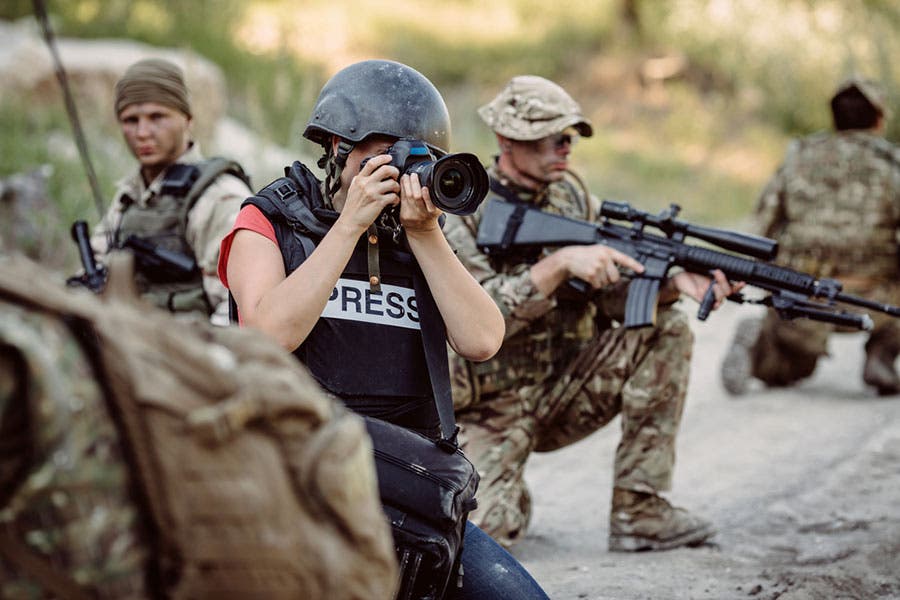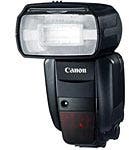What Cameras Do Photojournalists Use
Breaking into photojournalism isn't easy. In fact, it's arguably more challenging now than ever. But having the right bones equipment will help yous get started.

If you lot're seriously thinking most breaking into photojournalism, yes the right photojournalist gear is essential. Simply here are four words of warning: It won't be easy. In that location is a lot of competition out there, and fewer jobs to be had. Newspapers and magazines are cut staff and the immensely talented, experienced shooters they've dropped are working their butts off to stay in the game.
Are you certain you want to go up against them?
On the other hand, the Internet has opened upwards new niches that might be so limited in telescopic that they fly nether the radars of seasoned pros and just might assistance you get your foot in the door. Simply don't await to be able to pay your bills this mode, at least at outset. If you build a stunning portfolio of work (these days, very good isn't good enough) network persistently, and get your work noticed past the right people, you might have a fighting chance.
But you've got to start somewhere, and role of that is starting off with the right gear, and the right supplier. Adorama has been helping photojournalists get their starts—and keep going—with the right gear for decades.
Here are a few tips to help you buy smart. (Note: Production availability is authentic every bit of Oct. 22, 2012):
 1. Invest in proficient glass.
1. Invest in proficient glass.
Get the best lenses you can afford. Ideally, a broad-angle to normal zoom lens with a abiding f/2.8 wide aperture, such as the Nikon 17-35mm f/2.8D ED-IF AF-South and a tele zoom such as the Catechism seventy-200mm f/ii.8 are virtual requirements. If you lot can't afford these, at least get a couple of fast prime number lenses, like a Nikon 24mm f/ii.eight or Catechism 28mm f/1.8 wide angle, and a 180 or 200mm telephoto, plus a 50mm f/1.eight or f/i.4 (What'south the departure between an f/1.8 and f/1.4? Read the Adorama Learning Center's 50mm Lens Shoot-Out), and upgrade as the assignments start paying your bills. Bookmark the Adorama Lens Section for future orders.
Also read: "Upgrade Your eighteen-55mm Kit Lens and Plow Practiced Photographs Into Great Ones" at the Adorama Learning Eye
 2. Get ii DSLR bodies.
2. Get ii DSLR bodies.
Don't get the summit-end model. While total-frame is all-time, it costs a lot more; a high-end refurbished APS sensor DSLR (or fifty-fifty a used or refurbished total-frame) such as a Catechism 7D or Nikon D7000 can save y'all hundreds or even thousands, and give you outstanding depression-light operation, which yous'll need. As you move up and can afford it, yous tin can upgrade to the latest, greatest DSLR bodies and brand the jump to total-frame. The latest photojournalist-friendly full-frame models, such as a Canon 5D Mark 3 or Nikon D600, offer full HD video and a jack for an off-camera microphone. This will give y'all a competitive edge.
Also read: "The best mid-range DSLRs right now" at the Adorama Learning Middle.
 3. Buy a good omnidirectional microphone (if you're going to shoot videos).
3. Buy a good omnidirectional microphone (if you're going to shoot videos).
Don't rely on the on-camera mic; the audio won't exist broadcast quality. Get a adept, rugged handheld microphone, with a wind sock, for interviews or to capture ambient audio. The Electro-Vox RE50 microphone is a time-tested workhorse.
As well read: "Meliorate your HDSLR Video Sound with an External Microphone" at the Adorama Learning Center
 4. Bring a TTL strobe, either from the photographic camera maker or an contained flash company.
4. Bring a TTL strobe, either from the photographic camera maker or an contained flash company.
Only make sure yous have the proper cables and so the flash can communicate with your camera in total TTL style. Get the most powerful unit you can afford, such as the Canon Speedlite 600 EX-RT or Nikon SB-910. Even better: Brand information technology a wireless set up-upwards (no extra stuff needed with dedicated Nikon flash; Canon requires a wireless transmitter), or at least a TTL-friendly off-camera cord, so you tin movement the flash off the camera.
Too read: "The Golden Age of Wireless Photo Flash" at the Adorama Learning Center.
 v. Use a flash modifier.
v. Use a flash modifier.
At the very least, get a reflector so you tin bounce the flash or a diffuser to widen the flash source for more flattering lighting. This will allow you to get more than natural lighting. The LumiQuest ProMax Pocket Bouncer was one of the beginning popular lite modifiers for hot-shoe flashes, and for many photojournalists, it's withal 1 of the all-time.
Also read: "Who Else Wants More than Flattering Wink Photos?" at the Adorama Learning Center.
half dozen. Don't forget those extra, fully-charged batteries.
"I ran out of juice" is a reputation killer when shooting spot news or are on borderline. Bring at least two back-ups for each photographic camera and flash.
7. Ditto for memory cards.
Don't be stingy—purchase every bit many loftier-capacity cards as you lot tin—these things are dirt inexpensive. Buy the fastest memory carte you can afford, to accept advantage of your camera's burst rate and data transfer capabilities. This very well might make the difference betwixt getting the moment and missing it.
eight. Invest in tablet computer with a data plan.
iPad or 'Droid—whichever operating system yous're comfy with—as long as you tin can connect wirelessly via your provider's data plan (hint: invest in a data program!), and don't take to rely on the availability of Wi-Fi. The ability to file pictures from the field on a tight deadline is an absolute necessity. Go the data plan and go. (Likewise make sure to have Photoshop loaded so you tin do any very basic last-second exposure adjustments.) Alternatively, when shopping for a new camera, either look for a model with congenital-in wireless capabilities or with a grip or hot shoe unit that will turn information technology either into a bluetooth device (upload images via your jail cell phone) or a standalone wireless unit of measurement. There are lots of wireless options at present!
 nine. Pack sensor cleaners, microfiber cloth, etc.
nine. Pack sensor cleaners, microfiber cloth, etc.
You may be in the field nether less than ideal conditions, changing lenses. Be prepared to clean the lenses and sensor often. You don't want to brand a busy moving-picture show editor deal with sensor dust. That's an automatic "delete" no matter how adept the shot.
10. Throw in your smartphone…
…with all your film editors' contact info on speed dial.
And, as mentioned in detail 8, your phone might be pressed into service every bit a fashion to wirelessly transmit images from your photographic camera to your editor on tight deadline. Brand sure your data programme can handle it.
11. And a roll of gaffer tape, of course. Even if y'all don't think you'll need it, it's skilful to have effectually because eventually, y'all will. If room in your bag is at a premium, microGaffer tape is a very handy selection.
 12. Finally, become a good purse with room to grow.
12. Finally, become a good purse with room to grow.
This volition save you a few bucks in the long run. Make sure the bag has adjustable dividers then your gear will sit snugly.
Also read: "What's New in Camera Bags?" at the Adorama Learning Center.
There'south a lot more to breaking into photojournalism than simply having the right gear, and even if you do everything correct there'due south no guarantees that you will succeed. But at least investing in advisable equipment will put you on the right track. Good luck—yous'll need it!
Source: https://www.adorama.com/alc/12-must-have-items-for-photojournalists/
Posted by: bynumablued.blogspot.com


0 Response to "What Cameras Do Photojournalists Use"
Post a Comment